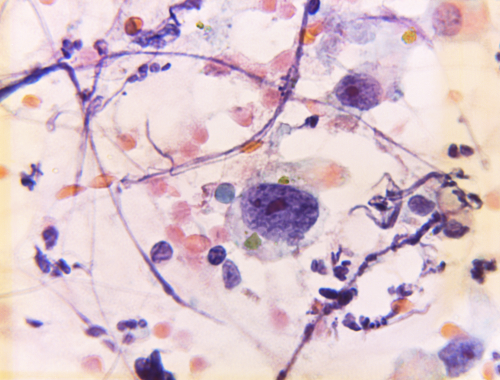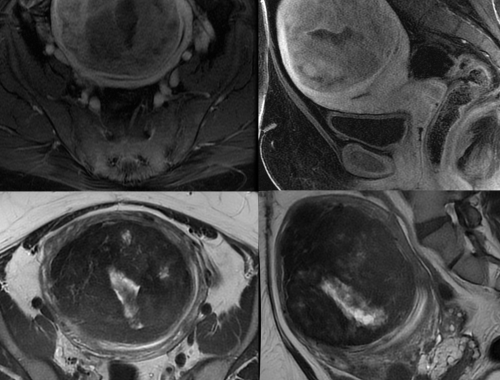Difference Between Endometriosis and Uterine Fibroids

Endometriosis develops when a portion of the endometrium (The layer of tissue that lines the uterus) separates from the uterus and spreads to other organs outside the uterus such as the ovaries (small, oval-shaped glands that are located on either side of your uterus), the fallopian tubes (bilateral conduits between the ovaries and the uterus), lungs, bladder, or large intestine.
Uterine fibroids, also termed as uterine myomas or leiomyomas are smooth benign (non-cancerous) muscular tumors that grow in a woman’s womb (uterus).

Similarity
Both endometriosis and uterine fibroids are conditions of the female reproductive system – the uterus. Some common symptoms include abnormal menstruation, pain during urination and pain during sexual intercourse.
Endometriosis
It is a condition when tissue that resembles the tissue that lines the uterus develops outside the uterus and into unnatural areas. Few symptoms include abnormal menstruation, infertility, constipation, cramping and abdominal fullness.
Uterine fibroids
Uterine fibroids are benign uterine growths that might appear in a woman during her reproductive years. The exact cause is unknown. However, the female hormone estrogen, family history of fibroids, a vitamin D deficiency, obesity, pressure in the abdomen and pelvic pain or early puberty initiation are risk factors. Medication and fibroid excision are among the available treatments.
Difference between Endometriosis and Uterine fibroids
Definition
Endometriosis – It is termed as an inflammatory disease in which a tissue just like the endometrial tissue grows in places outside of the uterus
Uterine fibroids – It is also termed as uterine myoma. These are benign and abnormal growths that develop in a woman’s womb during her reproductive years.
Causes
Endometriosis
Causative factors may include retrograde menstruation (when your period flows in an upward direction through your hollow, muscular ducts between your ovaries and your uterus – fallopian tubes and into your pelvis instead of out your vagina), the transformation of peritoneal cells (tissue that lines the abdominal wall and pelvic cavity) into endometrial tissue, and the transformation of embryonic cells (a cell derived from the early stages of an embryo) into endometrial-like cells. Risk factors for developing endometriosis may also include genetic factors.
Uterine fibroids
There are no specific causes for uterine fibroids. However scientific evidences claim that female hormone estrogen, vitamin D deficiency, red meat consumption, less green veggies consumption, and too much alcohol can increase your risk of developing fibroids.
Symptoms
Endometriosis
- Pain and discomfort both before and during periods
- Excessive menstrual cramps
- Experiencing pain during sexual activity
- Nausea, diarrhea, etc.
- Painful bowel movements and constipation
- Having difficulty urinating when on your period
- Discomfort while going to the bathroom while on your period
- Infertility (difficulty becoming pregnant).
Uterine fibroids
- Heavy menstrual bleeding
- Abdominal distension or cramp
- Pain during sexual intercourse
- Lower back pain
- Chronic vaginal discharge
- Urge to urinate frequently
Summary
The points of difference between Endometriosis and Uterine fibroids have been summarized as below:

FAQ:
What is the difference between endometriosis and uterine fibroids?
Endometriosis develops when a portion of the endometrium (The layer of tissue that lines the uterus) separates from the uterus and spreads to other organs outside the uterus such as the ovaries (small, oval-shaped glands that are located on either side of your uterus), the fallopian tubes (bilateral conduits between the ovaries and the uterus), lungs, bladder, or large intestine.
Uterine fibroids, also termed as uterine myomas or leiomyomas are smooth benign (non-cancerous) muscular tumors that grow in a woman’s womb (uterus)
Can endometriosis be mistaken for fibroids?
Some forms of uterine fibroids and endometriosis might present with identical signs and symptoms. Endometriosis and uterine fibroids can occasionally be confused for one another due to the symptoms’ similarity. Only by consulting a medical professional can either illness be accurately diagnosed. You can use this as a broad guide to tell if you have fibroids or endometriosis, even though it can be difficult to tell the difference.
Can endometriosis be mistaken for fibroids on ultrasound?
An ultrasound can rule out fibroids (non-cancerous growths that in or around the womb (uterus)), making endometriosis (tissue just like the lining of the uterus (endometrium) is present outside the uterus) the likely culprit.
How do you test for fibroids and endometriosis?
Ultrasound method is used by the gynecologists to test for fibroids and endometriosis. Other methods include pelvic exam and laparoscopy.
What is the best way to confirm endometriosis?
Your doctor will conduct a pelvic exam and feels palpates for abnormalities. The doctor may also suggest an ultrasound or MRI – Magnetic resonance imaging etc to identify any cysts or scars on your uterus. Laparoscopy is another best way to confirm endometriosis.
Can a gynecologist tell if you have fibroids?
The gynecologists will first scan your lower abdomen and carryout an ultrasound to confirm if you have fibroids.
What will a gynecologist do for fibroids?
In a laparoscopic operation (keyhole surgery or minimally invasive surgery) for removal of uterine fibroids and to evaluate and remove your fibroids, your gynecologist will use a camera, a few small incisions, and tiny surgical equipment as opposed to an open procedure, which requires a significant abdominal incision.
What can be mistaken for uterine fibroids?
Despite their similarities in symptoms, adenomyosis can be mistaken for uterine fibroids. A woman’s physical and emotional health can be affected by gynecological diseases such as fibroids and adenomyosis, which can result in heavy, uncomfortable periods.
Will a Pap smear show fibroid?
In order to identify possible precancerous processes (a condition in which any tumor or lesion that shows some abnormal cells with a potential of elevated risk of growing into cancer) before they have a chance to spread, a pap smear test involves taking cells from your cervix. Cervical fibroids can be identified during this regular test because your doctor will examine your cervix and collect cells on a swab.
- Difference Between Global Warming and Greenhouse Effect - May 18, 2024
- Difference Between Vaccination and Immunization - March 3, 2024
- Difference Between Selective Mutism and Autism - February 25, 2024
Search DifferenceBetween.net :
Leave a Response
References :
[0]Bulun, S. E. (2013). Uterine fibroids. New England Journal of Medicine, 369(14), 1344-1355.
[1]Lebovic, D. I., Mueller, M. D., & Taylor, R. N. (2001). Immunobiology of endometriosis. Fertility and sterility, 75(1), 1-10.
[2]Stewart, E. A., Laughlin-Tommaso, S. K., Catherino, W. H., Lalitkumar, S., Gupta, D., & Vollenhoven, B. (2016). Uterine fibroids. Nature reviews Disease primers, 2(1), 1-18.
[3]Symons, L. K., Miller, J. E., Kay, V. R., Marks, R. M., Liblik, K., Koti, M., & Tayade, C. (2018). The immunopathophysiology of endometriosis. Trends in molecular medicine, 24(9), 748-762.
